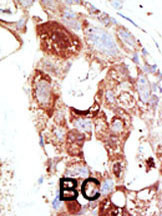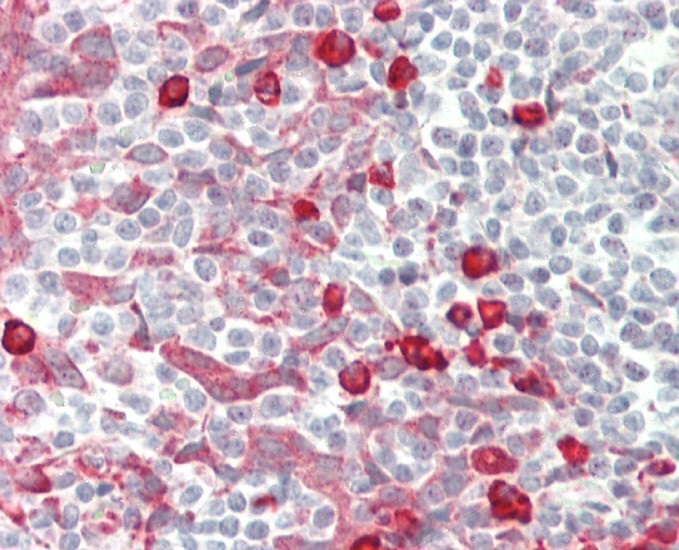SENP6 Antibody (C-term)
Purified Rabbit Polyclonal Antibody (Pab)
- SPECIFICATION
- CITATIONS: 4
- PROTOCOLS
- BACKGROUND

Application
| IHC-P, WB, E |
|---|---|
| Primary Accession | Q9GZR1 |
| Reactivity | Human |
| Host | Rabbit |
| Clonality | Polyclonal |
| Isotype | Rabbit IgG |
| Calculated MW | 126146 Da |
| Antigen Region | 1081-1112 aa |
| Gene ID | 26054 |
|---|---|
| Other Names | Sentrin-specific protease 6, SUMO-1-specific protease 1, Sentrin/SUMO-specific protease SENP6, SENP6, KIAA0797, SSP1, SUSP1 |
| Target/Specificity | This SENP6 antibody is generated from rabbits immunized with a KLH conjugated synthetic peptide between 1081-1112 amino acids from the C-terminal region of human SENP6. |
| Dilution | IHC-P~~1:100 WB~~1:1000 E~~Use at an assay dependent concentration. |
| Format | Purified polyclonal antibody supplied in PBS with 0.09% (W/V) sodium azide. This antibody is prepared by Saturated Ammonium Sulfate (SAS) precipitation followed by dialysis against PBS. |
| Storage | Maintain refrigerated at 2-8°C for up to 2 weeks. For long term storage store at -20°C in small aliquots to prevent freeze-thaw cycles. |
| Precautions | SENP6 Antibody (C-term) is for research use only and not for use in diagnostic or therapeutic procedures. |
| Name | SENP6 |
|---|---|
| Synonyms | KIAA0797, SSP1, SUSP1 |
| Function | Protease that deconjugates SUMO1, SUMO2 and SUMO3 from targeted proteins. Processes preferentially poly-SUMO2 and poly-SUMO3 chains, but does not efficiently process SUMO1, SUMO2 and SUMO3 precursors. Deconjugates SUMO1 from RXRA, leading to transcriptional activation. Involved in chromosome alignment and spindle assembly, by regulating the kinetochore CENPH-CENPI-CENPK complex. Desumoylates PML and CENPI, protecting them from degradation by the ubiquitin ligase RNF4, which targets polysumoylated proteins for proteasomal degradation. Also desumoylates RPA1, thus preventing recruitment of RAD51 to the DNA damage foci to initiate DNA repair through homologous recombination. |
| Cellular Location | Nucleus |
| Tissue Location | Highly expressed in reproductive organs, such as testis, ovary and prostate |

Provided below are standard protocols that you may find useful for product applications.
Background
SENP6 (SUSP1) is a protease that deconjugates SUMO1, SUMO2 and SUMO3 from targeted proteins. This protein does not seem to be involved in the processing of full-length SUMO proteins to their mature conjugatable forms. SENP6 deconjugates SUMO1 from RXRA, leading to transcriptional activation. It may act preferentially on substrates containing 3 or more SUMO2 or SUMO3 moieties.
References
Ota, T., et al., Nat. Genet. 36(1):40-45 (2004).
Strausberg, R.L., et al., Proc. Natl. Acad. Sci. U.S.A. 99(26):16899-16903 (2002).
Kim, K.I., et al., J. Biol. Chem. 275(19):14102-14106 (2000).
If you have used an Abcepta product and would like to share how it has performed, please click on the "Submit Review" button and provide the requested information. Our staff will examine and post your review and contact you if needed.
If you have any additional inquiries please email technical services at tech@abcepta.com.














 Foundational characteristics of cancer include proliferation, angiogenesis, migration, evasion of apoptosis, and cellular immortality. Find key markers for these cellular processes and antibodies to detect them.
Foundational characteristics of cancer include proliferation, angiogenesis, migration, evasion of apoptosis, and cellular immortality. Find key markers for these cellular processes and antibodies to detect them. The SUMOplot™ Analysis Program predicts and scores sumoylation sites in your protein. SUMOylation is a post-translational modification involved in various cellular processes, such as nuclear-cytosolic transport, transcriptional regulation, apoptosis, protein stability, response to stress, and progression through the cell cycle.
The SUMOplot™ Analysis Program predicts and scores sumoylation sites in your protein. SUMOylation is a post-translational modification involved in various cellular processes, such as nuclear-cytosolic transport, transcriptional regulation, apoptosis, protein stability, response to stress, and progression through the cell cycle. The Autophagy Receptor Motif Plotter predicts and scores autophagy receptor binding sites in your protein. Identifying proteins connected to this pathway is critical to understanding the role of autophagy in physiological as well as pathological processes such as development, differentiation, neurodegenerative diseases, stress, infection, and cancer.
The Autophagy Receptor Motif Plotter predicts and scores autophagy receptor binding sites in your protein. Identifying proteins connected to this pathway is critical to understanding the role of autophagy in physiological as well as pathological processes such as development, differentiation, neurodegenerative diseases, stress, infection, and cancer.



